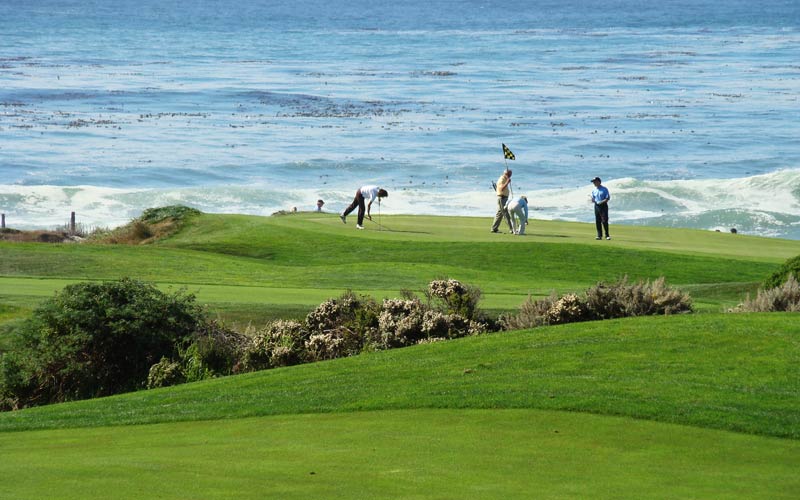Every once in awhile I receive an email that brings equal amounts of surprise and wonder.
I don’t know how he tracked me down, but last week, a retired 70-year-old in Wilmington, Del. sent me a brief note.
“I finished the top 100 courses,” it read. “Thanks for writing the book. I enjoyed it and the courses. There a story today (Sept. 22) in the Monterey Herald.” Sean McKinley.
And so I read the attached newspaper story on the man’s feat.
McKinley received a copy of my coffee table book, Top 100 Courses You Can Play, for Christmas in 1999. While flipping through it, the soon-to-be-retired engineer, an avid golfer with an 18 handicap, dreamed up the idea of playing every course on the list.
.jpg)
McKinley's world was rocked by Bethpage Black
He took a golf vacation to the No. 1 course on the roster, Pebble Beach, on Sept. 5, 2000 and returned to play there again on Aug. 31 of this year, completing an amazing circle.
According to the Monterey Herald report, McKinley thoroughly enjoyed his round at Pebble, but his favorite course on the Monterey Peninsula was Spyglass Hill (No. 5). He ranks Spyglass only behind Bethpage Black on Long Island as the best public-access course in the nation. A glutton for punishment, he managed to played the Black four times. As a native New Yorker, I marveled at the tale of his craftiness.
While anyone can tee it up at Bethpage—it’s a state park with 90 holes of golf—securing a tee time on the Black, a two-time U.S. Open venue, usually requires a big commitment. Green fees on the Black for New York residents are a relative bargain at $65/$75 weekday/weekend, with non-residents charged $130/$150. However, securing a tee time on the Black, especially on a weekend, often requires queuing up and sleeping in the parking lot overnight for the privilege of wrestling a man-eater.
McKinley found a loophole in the system. He “figured out through a friend that he could make a tee time by calling the pro shop directly—via a hospital phone,” according to the story. “A friend’s sister booked the tee time from the hospital, which evidently has priority over the flood of calls trying to get through.”
McKinley’s first round at Bethpage Black was a 99, but he said he felt much better about how he played after watching the world’s best golfers struggle at 2002 U.S. Open held there.
“The toughest course (among the Top 100) was Bethpage Black, but it was also the most enjoyable,” McKinley said. “It was incredible, but it was just brutal.” Proving once again that most campaigners with double-digit handicaps are masochists.
The best value on McKinley’s 11-year golf odyssey? Pinon Hills in Farmington, N.M., which I described in the book as the “Best Bang for the Buck in America.” In the late ‘90s, this high-desert muni was priced at $12.50 on weekdays, $15 on weekends. The rates are a bit north of that now, but it’s still among the best courses for the money anywhere. Just be sure to top off the tank—Pinon Hills is nearly 200 miles from either Albuquerque or Santa Fe.

Spanish Bay was the retired engineer's final Top 100 course
McKinley’s latest trip to the Monterey Peninsula included rounds at Pasatiempo (No. 17) and Spanish Bay (No. 45), the latter his final course on the list. As McKinley walked up the 18th fairway at Spanish Bay on Aug. 30, he was serenaded by the resort’s bagpiper and followed by a gallery of his friends and family. Everyone in his gallery wore green hats that read, “McKinley Golf March 1,800 Holes,” but his journey was longer than that.
Wisely, McKinley made a detour to Bandon Dunes after playing Pumpkin Ridge – Ghost Creek (No. 13), Sunriver – Crosswater (No. 15) and Sandpines (No. 72) to sample the courses that were built after the book was published. I did devote a page to Bandon Dunes based on a day spent with David McLay Kidd in May, 1998 on the site of the resort’s eponymous first course. It was abundantly clear that developer Mike Keiser’s dream of building a walker’s-only retreat on the remote southern Oregon coast was destined for greatness. Were my book to be updated today, Bandon’s four courses would dominate the top of the list.
Similarly, McKinley teed it up at newer Whistling Straits when he visited Kohler, Wis. to play the River and Meadow Valleys courses at Blackwolf Run. Here again, I devoted a few pages to preview to the Straits and was fortunate to have Pete Dye take me around the former military encampment on the shores of Lake Michigan to witness one of the greatest earthmoving campaigns ever undertaken for the purposes of building a golf course. I noticed during our tour that the bulldozer operators seemed unusually young. I asked Pete about it. “Most of these kids are just out of high school,” he whispered. “I didn’t want to hire anyone who actually knew what they were doing. All I told them to do is ‘Push and dump, push and dump.’” Which is why the Straits looks and plays the way it does.
Back to McKinley. His scoring average at the Top 100 Courses You Can Play was 94.4, which is pretty respectable. “I got down to a 15 or 16 handicap, but I never could do much better than that,” he said. A decent game, slightly better than bogey golf, and more than good enough to roam the country to complete a bucket list. Proving once again that golfers, regardless of ability, dwell in the realm of hopes and dreams.
Now if only McKinley will give me the name of that hospital on Long Island.
